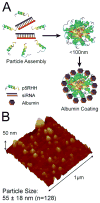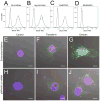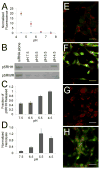Mechanisms of nanoparticle-mediated siRNA transfection by melittin-derived peptides
- PMID: 24053333
- PMCID: PMC4013830
- DOI: 10.1021/nn403311c
Mechanisms of nanoparticle-mediated siRNA transfection by melittin-derived peptides
Abstract
Traditional peptide-mediated siRNA transfection via peptide transduction domains exhibits limited cytoplasmic delivery of siRNA due to endosomal entrapment. This work overcomes these limitations with the use of membrane-destabilizing peptides derived from melittin for the knockdown of NFkB signaling in a model of adult T-cell leukemia/lymphoma. While the mechanism of siRNA delivery into the cytoplasmic compartment by peptide transduction domains has not been well studied, our analysis of melittin derivatives indicates that concurrent nanocomplex disassembly and peptide-mediated endosomolysis are crucial to siRNA transfection. Importantly, in the case of the most active derivative, p5RHH, this process is initiated by acidic pH, indicating that endosomal acidification after macropinocytosis can trigger siRNA release into the cytoplasm. These data provide general principles regarding nanocomplex response to endocytosis, which may guide the development of peptide/siRNA nanocomplex-based transfection.
Figures




 ), but not the non-functioning peptide p5RWR (
), but not the non-functioning peptide p5RWR (
 ). (b) Polyacrylamide gel electrophoresis confirms that p5RHH releases siRNA at pH 4.5 but p5RWR shows no pH-dependent release. (c) p5RHH is also released at low pH with an increase in p5RHH release at pH ≤ 5.5. (d) Freed p5RHH is capable of hemolysis, leading to increased hemoglobin release at pH ≤ 5.5. (e–h) Acridine orange release assays show that p5RHH/siRNA nanoparticles are able to disrupt endosomes (h) when tested in tissue culture, as exhibited by dye release similar to that of 100μM chloroquine (f), whereas p5RWR cannot (g). Scale bar 50μm.
). (b) Polyacrylamide gel electrophoresis confirms that p5RHH releases siRNA at pH 4.5 but p5RWR shows no pH-dependent release. (c) p5RHH is also released at low pH with an increase in p5RHH release at pH ≤ 5.5. (d) Freed p5RHH is capable of hemolysis, leading to increased hemoglobin release at pH ≤ 5.5. (e–h) Acridine orange release assays show that p5RHH/siRNA nanoparticles are able to disrupt endosomes (h) when tested in tissue culture, as exhibited by dye release similar to that of 100μM chloroquine (f), whereas p5RWR cannot (g). Scale bar 50μm.
 ); 50nM a488 siRNA/p5RWR (
); 50nM a488 siRNA/p5RWR (
 ); 50nM a88 siRNA/p5RWR + chloroquine (
); 50nM a88 siRNA/p5RWR + chloroquine (
 ); 50nM a488 siRNA/p5RHH (
); 50nM a488 siRNA/p5RHH (
 ); 50nM a88 siRNA/p5RHH + chloroquine (
); 50nM a88 siRNA/p5RHH + chloroquine (
 ). Confocal microscopy (scale bar 10μm) reveals that p5RWR (c) delivers siRNA by remains in punctate vesicles whereas p5RHH achieves cytoplasmic distribution (d). Simultaneous incubation with chloroquine is required to release siRNA to the cytoplasm when transfected by p5RWR (e) but has no effect on p5RHH-mediated transfection (f).
). Confocal microscopy (scale bar 10μm) reveals that p5RWR (c) delivers siRNA by remains in punctate vesicles whereas p5RHH achieves cytoplasmic distribution (d). Simultaneous incubation with chloroquine is required to release siRNA to the cytoplasm when transfected by p5RWR (e) but has no effect on p5RHH-mediated transfection (f).
Similar articles
-
Melittin derived peptides for nanoparticle based siRNA transfection.Biomaterials. 2013 Apr;34(12):3110-9. doi: 10.1016/j.biomaterials.2013.01.037. Epub 2013 Feb 4. Biomaterials. 2013. PMID: 23380356 Free PMC article.
-
A role for peptides in overcoming endosomal entrapment in siRNA delivery - A focus on melittin.Biotechnol Adv. 2015 Nov 1;33(6 Pt 1):931-40. doi: 10.1016/j.biotechadv.2015.05.005. Epub 2015 May 27. Biotechnol Adv. 2015. PMID: 26025036 Free PMC article. Review.
-
Endosomolysis by masking of a membrane-active agent (EMMA) for cytoplasmic release of macromolecules.Bioconjug Chem. 2003 Jan-Feb;14(1):51-7. doi: 10.1021/bc0255945. Bioconjug Chem. 2003. PMID: 12526692
-
Trileucine residues in a ligand-CPP-based siRNA delivery platform improve endosomal escape of siRNA.J Drug Target. 2017 Apr;25(4):320-329. doi: 10.1080/1061186X.2016.1258566. Epub 2016 Nov 22. J Drug Target. 2017. PMID: 27820977
-
Melittin: a membrane-active peptide with diverse functions.Biosci Rep. 2007 Oct;27(4-5):189-223. doi: 10.1007/s10540-006-9030-z. Biosci Rep. 2007. PMID: 17139559 Review.
Cited by
-
Peptide Spiders: Peptide-Polymer Conjugates to Traffic Nucleic Acids.Mol Pharm. 2020 Sep 8;17(9):3633-3642. doi: 10.1021/acs.molpharmaceut.0c00714. Epub 2020 Jul 27. Mol Pharm. 2020. PMID: 32786959 Free PMC article.
-
Peptide-siRNA nanoparticles targeting NF-κB p50 mitigate experimental abdominal aortic aneurysm progression and rupture.Biomater Adv. 2022 Aug;139:213009. doi: 10.1016/j.bioadv.2022.213009. Epub 2022 Jul 2. Biomater Adv. 2022. PMID: 35891603 Free PMC article.
-
NF-κB Inhibition Suppresses Experimental Melanoma Lung Metastasis.J Cancer Sci Clin Ther. 2020;4(3):256-265. doi: 10.26502/jcsct.5079070. Epub 2020 Aug 14. J Cancer Sci Clin Ther. 2020. PMID: 32954352 Free PMC article.
-
Self-Assembled Aptamer-Nanomedicine for Targeted Chemotherapy and Gene Therapy.Small. 2018 Jan;14(4):10.1002/smll.201702103. doi: 10.1002/smll.201702103. Epub 2017 Dec 4. Small. 2018. PMID: 29205808 Free PMC article.
-
Trojan horses and guided missiles: targeted therapies in the war on arthritis.Nat Rev Rheumatol. 2015 Jun;11(6):328-37. doi: 10.1038/nrrheum.2015.17. Epub 2015 Mar 3. Nat Rev Rheumatol. 2015. PMID: 25734971 Review.
References
-
- Fire A, Xu S, Montgomery MK, Kostas SA, Driver SE, Mello CC. Potent and Specific Genetic Interference by Double-Stranded RNA in Caenorhabditis Elegans. Nature. 1998;391:806–811. - PubMed
-
- Elbashir SM, Harborth J, Lendeckel W, Yalcin A, Weber K, Tuschl T. Duplexes of 21-Nucleotide RNAs Mediate RNA Interference in Cultured Mammalian Cells. Nature. 2001;411:494–498. - PubMed
-
- Dominska M, Dykxhoorn DM. Breaking Down the Barriers: siRNA Delivery and Endosome Escape. J Cell Sci. 2010;123:1183–1189. - PubMed
Publication types
MeSH terms
Substances
Grants and funding
LinkOut - more resources
Full Text Sources
Other Literature Sources

